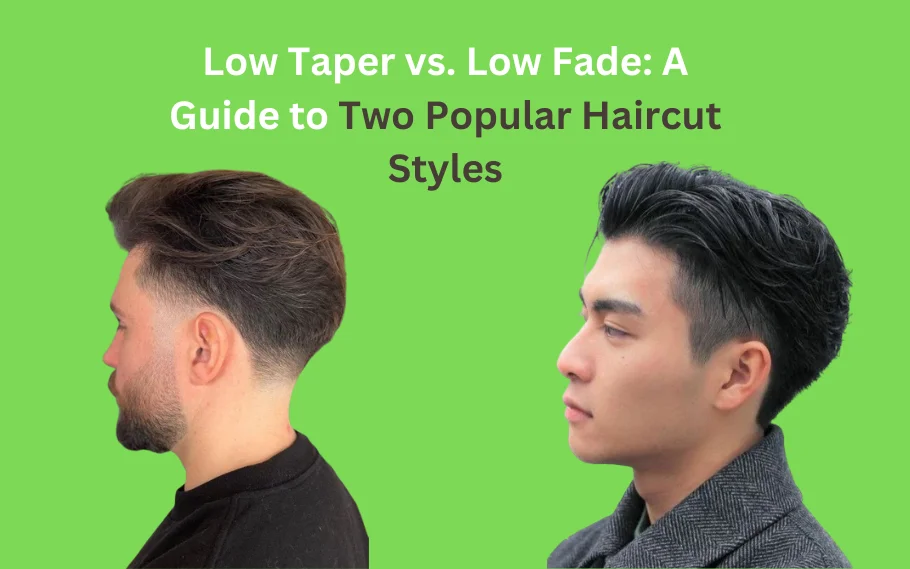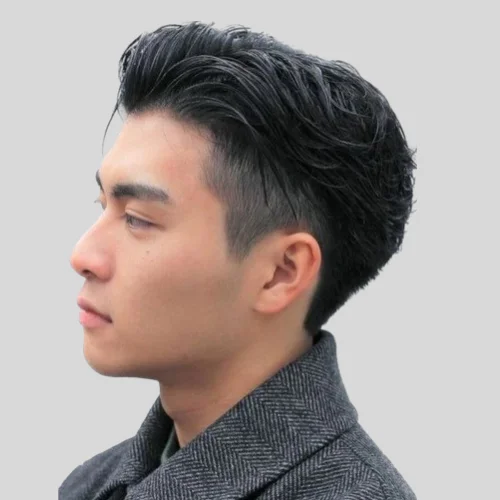Low Taper vs. Low Fade: A Guide to Two Popular Haircut Styles

Regarding men’s haircuts, two terms frequently come up: “low taper” and “low fade.” Both are popular styles, but they often confuse people because they can look quite similar at first glance. In this blog post, we’ll explore the differences, advantages, and ideal situations for choosing between these two styles. By the end, you’ll have a clearer understanding of which might suit your style and needs better.
What Is a Low Taper?
A low taper is a haircut where the hair gradually shortens, beginning at the top of the head and tapering down towards the sides and back. The key word here is “gradually.” The taper starts at the bottom of the head, just above the neckline, and slowly blends the hair shorter as it moves toward the ears.

Unlike other cuts, a taper doesn’t completely shave the sides. Instead, the hair becomes progressively shorter, but it remains visible. The taper can be gentle, making the hair change length smoothly. It’s a style that works well with various hair textures and lengths, making it quite versatile. Whether you have curly, wavy, or straight hair, a taper can enhance your haircut’s overall shape.
Benefits of a Low Taper
- Clean Look Without Extreme Shortness: If you want a clean and polished look but don’t want to go too short, the low taper is a great option. It keeps your hair neat but leaves enough length for a softer appearance.
- Versatile for Different Hairstyles: You can pair a low taper with many different hairstyles, from pompadours and comb-overs to slicked-back looks and textured tops.
- Professional Appeal: This haircut has a neat, classy appearance that suits professional settings. It’s not too edgy but still modern and stylish. Gradual Transition: The slow transition from longer to shorter hair helps create a natural look. It doesn’t draw too much attention to the sides or the back of the head, which can be a plus for those who prefer understated haircuts.
- Easy to Maintain: Since the low taper doesn’t involve an extreme cut, it’s fairly easy to maintain. It also grows out well, making it a good choice if you can’t visit the barber often.
What Is a Low Fade?

A low fade haircut also involves gradually shortening the hair on the sides and back, but the fade is more dramatic than a taper. In a fade, the hair on the sides and back becomes extremely short, and in some cases, it’s buzzed down to the skin. The fade starts lower on the head (hence the name “low fade”), around the temple, or just above the ear.
“fade” refers to how the hair length “fades” from long to very short. This can create a sharper contrast between the top of the head, where the hair is longer, and the sides or back, where the hair is significantly shorter. Low fades are often paired with bolder hairstyles, where the contrast between long and short hair is part of the look.
Benefits of a Low Fade
- Edgier, Modern Style: A low fade provides a sharper, more noticeable transition compared to a taper. This haircut is a great choice for those who want a modern and clean look.
- Low Maintenance on the Sides: Since the hair is cut very short or even shaved, a low fade reduces the need for frequent styling on the sides and back of the head. It’s especially helpful for those who prefer to focus on styling the hair on top.
- Sharp Contrast: The low fade creates a distinct difference between the longer hair on top and the shorter sides, making it a bold, eye-catching haircut ideal for those who want to stand out.
- Pairs Well with Textured Hairstyles: Low fades are great for textured, voluminous hairstyles on top. Whether you like a messy, casual look or a neat and smooth style, the low fade gives a great starting point for either.
- Keeps You Cool: The shorter sides and back of a low fade can help keep you cool during warm weather. It’s a practical option for those who live in hot climates or want a haircut that reduces heat buildup.
Key Differences Between Low Taper and Low Fade

Transition of Hair Length:
- Low Taper: The hair gradually gets shorter from top to bottom but doesn’t go down to the skin. The change is more gentle.
- Low Fade: The hair on the sides and back fades to a much shorter length, often down to the skin, creating a stronger contrast.
Look and Feel:
- Low Taper: Offers a softer, more natural look with less of a contrast between the different lengths of hair. It’s smooth and understated, making it a flexible option.
- Low Fade: Features a more striking, edgy look due to the sharp contrast between the long hair on top and the very short or shaved sides and back.
Maintenance:
- Low Taper: The taper grows out more naturally, so it requires less upkeep. You won’t need frequent touch-ups, and it won’t look messy as it grows.
- Low Fade: Since the fade has very short or shaved parts, it needs to be trimmed more often to stay looking good. As the hair grows, the fade can lose its defined shape.
Best for Different Styles:
- Low Taper: Works well with classic, understated hairstyles. If you prefer a timeless, professional look, the low taper is likely a better fit.
- Low Fade: Fits more daring, modern styles. If you want to show off a textured or voluminous hairstyle and aren’t afraid of a bold look, the low fade is a good choice.
Which One Is Right for You?
Deciding between a low taper and a low fade depends on a few things, like your personal style, how much upkeep you want, and the appearance you wish to create.
For a Subtle, Professional Look: If you want a haircut that’s easy to style, suitable for professional settings, and grows out well without too much fuss, the low taper is probably your best bet. It offers a clean look without being too dramatic, making it ideal for those who prefer a low-maintenance yet stylish cut.
For a Bold, Trendy Look: If you’re someone who loves bold hairstyles and doesn’t mind putting in a bit more effort to maintain your cut, the low fade is a great choice. It’s stylish and contemporary, making it ideal for standing out.

Consider Your Face Shape: Both haircuts can be tailored to suit different face shapes, but there are general guidelines to consider. Low tapers can soften angular faces, while low fades can add definition to rounder faces. If you’re not sure which works best, ask your barber for advice based on your face shape.
Maintenance Level: If you can’t visit the barber regularly, the low taper is easier to maintain since it grows out more smoothly. A low fade, while stylish, requires more frequent upkeep to keep the sharp lines intact.
Hair Texture and Type: Both the low taper and low fade work well with most hair types, but they can emphasize different aspects of your hair. A taper might enhance your hair’s natural volume and texture, while a fade could focus more on the contrast between your hair’s top and sides. Curly, wavy, or straight hair can all benefit from either style, but it’s worth considering how much you want to emphasize your hair’s texture.

Conclusion:
Both the low taper and low fade are excellent haircut styles that can be adapted to fit your individual preferences and lifestyle. The low taper is more subtle and professional, while the low fade is bolder and more modern. Ultimately, the right choice comes down to how you want to present yourself, how much maintenance you’re willing to commit to, and how much contrast you prefer between the top and sides of your hair. Whether you’re opting for the refined look of a taper or the edgy style of a fade, both cuts can enhance your overall appearance and give you a fresh, updated look. Talk to your barber about which option is best for your hair type, face shape, and lifestyle to ensure you leave the chair with the perfect cut for you!






